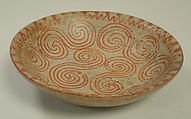Bowl
Not on view
This bowl, covered with concentric spirals and inverted “S” motifs that emulate sinuous waves, represents the fusion of both coastal and highland craft traditions, in a style known as Coastal Cajamarca, popularized across the mid-Jequetepeque Valley, Peru, between the fourth and seventh centuries A.D. Cajamarca potters of the northern highlands developed a highly distinctive style that was at once simple and sophisticated, a source of aesthetic inspiration for artists in both neighboring and distant regions. This vessel features delicate red motifs on a cream background—the cream reflecting the color of the kaolin paste typically used by Cajamarca potters since the beginning of the first millennium A.D. Potters in the coastal mid-Jequetepeque Valley, inspired by Cajamarca, poured their expertise into the production of fancy bowls, plates, jars and spoons. These were finely painted using a red slip on a cream background, an aesthetic strongly associated with artistic canons of the Moche, their better-known neighbors on the coast (see, for example, accession number 65.266.3 and 63.226.13, among others).
Stylized sea-related motifs, like the waves represented in a symmetrical arrangement on this bowl, along with geometric and other schematic designs, became part of a corpus of iconographic motifs shared across northern Peru between the fourth and seventh centuries A.D., a period of intensive regional interaction and stylistic exchange. Based on the distribution of the coveted Cajamarca-style vessels, this economic network included the highland Cajamarca Basin, the coastal Moche and Lambayeque valleys, Huamachuco and the Callejón de Huaylas in the highlands, and even Chachapoyas on the eastern slopes of the Andes. Although the distribution of Cajamarca pottery eventually became far more ubiquitous, reaching the south and central highlands between the eighth and eleventh centuries A.D., Coastal Cajamarca pottery across the Andes seems to have been limited primarily to the north coast and highlands. Most well-known examples of this type of vessel come from the ceremonial centers at Chornancap and Huaca de La Luna on the Peruvian north coast.
While few of their original contexts of use have been thoroughly investigated, these bowls seem to have been commonly—and actively— used in feasts and rituals, and particularly designed to be manipulated. The emphasis on the interior surface requires a direct engagement between the user and the object, rather than contemplation from afar. It is also likely that these vessels were part of communal feasts, social events designed to help summon and organize local labor.
Patricia Chirinos-Ogata, Department of Anthropology, University of California, Santa Barbara, 2021
Further reading and references
Bernuy, K., and Bernal, V. (2008). La tradición Cajamarca en San José de Moro: Una evidencia de interacción interregional durante el Horizonte Medio. In L. J. Castillo, H. Bernier, G. Lockard, & J. Rucabado (Eds.), Arqueología Mochica: Nuevos enfoques (pp. 67-80). Lima: Pontificia Universidad Católica del Perú.
Toohey, J. L., and Chirinos, P. (2018). La tradición Cajamarca y la sierra norte del Perú. In L. J. Castillo & E. Mujica (Eds.), Perú prehispánico: Un estado de la cuestión (pp. 185-208). Cusco: Ministerio de Cultura-DDC Cusco.
Tsai, H. I. (2019). The "Coastal Cajamarca" Style Did Not Come from the Coast. Ñawpa Pacha, 39(1), 121-144.
Wester La Torre, C. (2018). Personajes de élite en Chornancap. Una nueva visión de la cultura Lambayeque. Lima: Ministerio de Cultura / Museo Arqueológico Brüning.
This image cannot be enlarged, viewed at full screen, or downloaded.
This artwork is meant to be viewed from right to left. Scroll left to view more.



